stop start YAMAHA WR 450F 2016 User Guide
[x] Cancel search | Manufacturer: YAMAHA, Model Year: 2016, Model line: WR 450F, Model: YAMAHA WR 450F 2016Pages: 426, PDF Size: 10.86 MB
Page 66 of 426
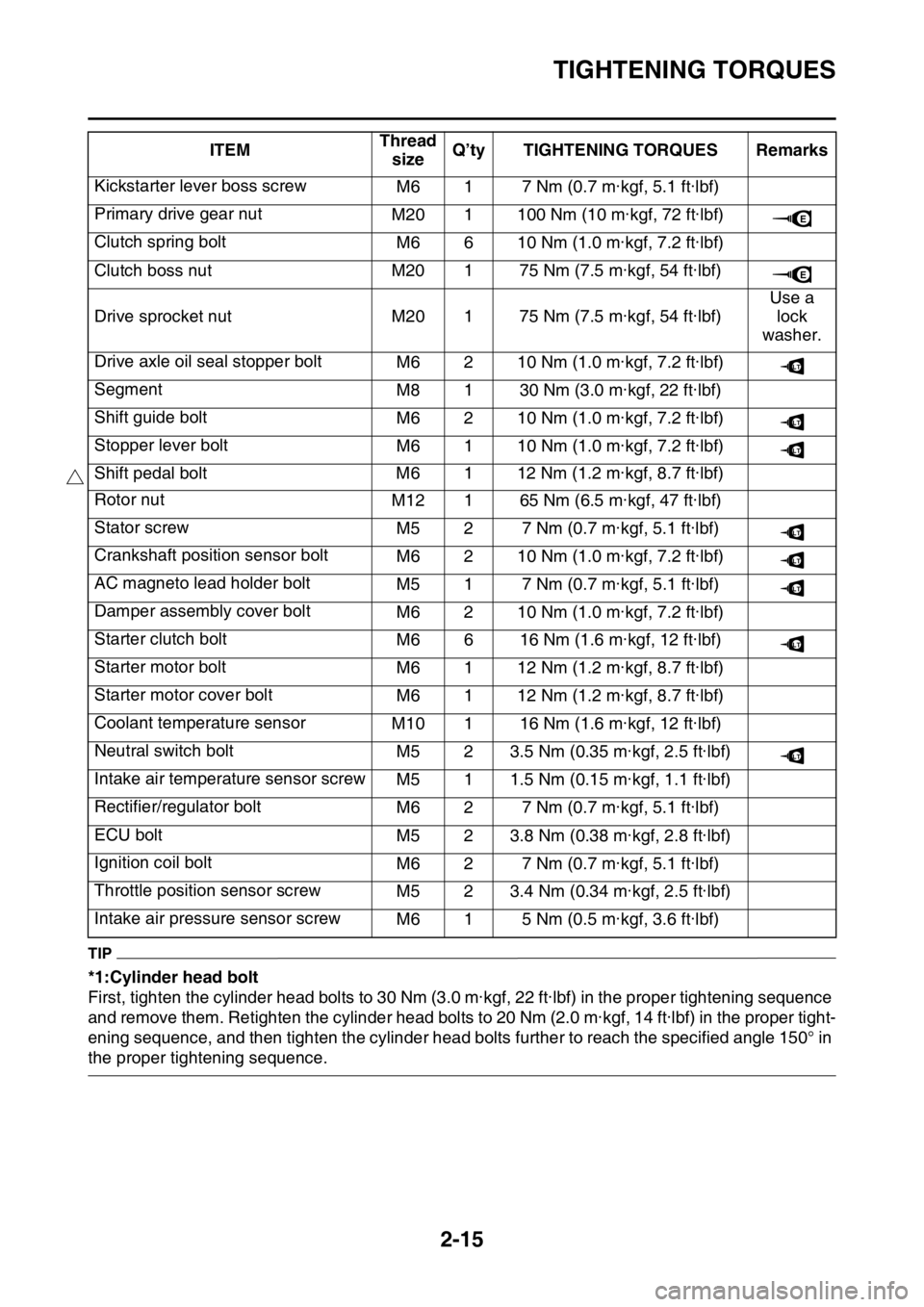
TIGHTENING TORQUES
2-15
TIP
*1:Cylinder head bolt
First, tighten the cylinder head bolts to 30 Nm (3.0 m·kgf, 22 ft·lbf) in the proper tightening sequence
and remove them. Retighten the cylinder head bolts to 20 Nm (2.0 m·kgf, 14 ft·lbf) in the proper tight-
ening sequence, and then tighten the cylinder head bolts further to reach the specified angle 150° in
the proper tightening sequence.Kickstarter lever boss screw
M6 1 7 Nm (0.7 m·kgf, 5.1 ft·lbf)
Primary drive gear nut M20 1 100 Nm (10 m·kgf, 72 ft·lbf)
Clutch spring bolt M6 6 10 Nm (1.0 m·kgf, 7.2 ft·lbf)
Clutch boss nut M20 1 75 Nm (7.5 m·kgf, 54 ft·lbf)
Drive sprocket nut M20 1 75 Nm (7.5 m·kgf, 54 ft·lbf) Use a
lock
washer.
Drive axle oil seal stopper bolt M6 2 10 Nm (1.0 m·kgf, 7.2 ft·lbf)
Segment M8 1 30 Nm (3.0 m·kgf, 22 ft·lbf)
Shift guide bolt M6 2 10 Nm (1.0 m·kgf, 7.2 ft·lbf)
Stopper lever bolt M6 1 10 Nm (1.0 m·kgf, 7.2 ft·lbf)
Shift pedal bolt M6 1 12 Nm (1.2 m·kgf, 8.7 ft·lbf)
Rotor nut M12 1 65 Nm (6.5 m·kgf, 47 ft·lbf)
Stator screw M5 2 7 Nm (0.7 m·kgf, 5.1 ft·lbf)
Crankshaft position sensor bolt M6 2 10 Nm (1.0 m·kgf, 7.2 ft·lbf)
AC magneto lead holder bolt M5 1 7 Nm (0.7 m·kgf, 5.1 ft·lbf)
Damper assembly cover bolt M6 2 10 Nm (1.0 m·kgf, 7.2 ft·lbf)
Starter clutch bolt M6 6 16 Nm (1.6 m·kgf, 12 ft·lbf)
Starter motor bolt M6 1 12 Nm (1.2 m·kgf, 8.7 ft·lbf)
Starter motor cover bolt M6 1 12 Nm (1.2 m·kgf, 8.7 ft·lbf)
Coolant temperature sensor M10 1 16 Nm (1.6 m·kgf, 12 ft·lbf)
Neutral switch bolt M5 2 3.5 Nm (0.35 m·kgf, 2.5 ft·lbf)
Intake air temperature sensor screw M5 1 1.5 Nm (0.15 m·kgf, 1.1 ft·lbf)
Rectifier/regulator bolt M6 2 7 Nm (0.7 m·kgf, 5.1 ft·lbf)
ECU bolt M5 2 3.8 Nm (0.38 m·kgf, 2.8 ft·lbf)
Ignition coil bolt M6 2 7 Nm (0.7 m·kgf, 5.1 ft·lbf)
Throttle position sensor screw M5 2 3.4 Nm (0.34 m·kgf, 2.5 ft·lbf)
Intake air pressure sensor screw M6 1 5 Nm (0.5 m·kgf, 3.6 ft·lbf)
ITEM
Thread
size Q’ty TIGHTENING TORQUES Remarks
E
E
LT
LT
LT
LT
LT
LT
LT
LT
Page 68 of 426
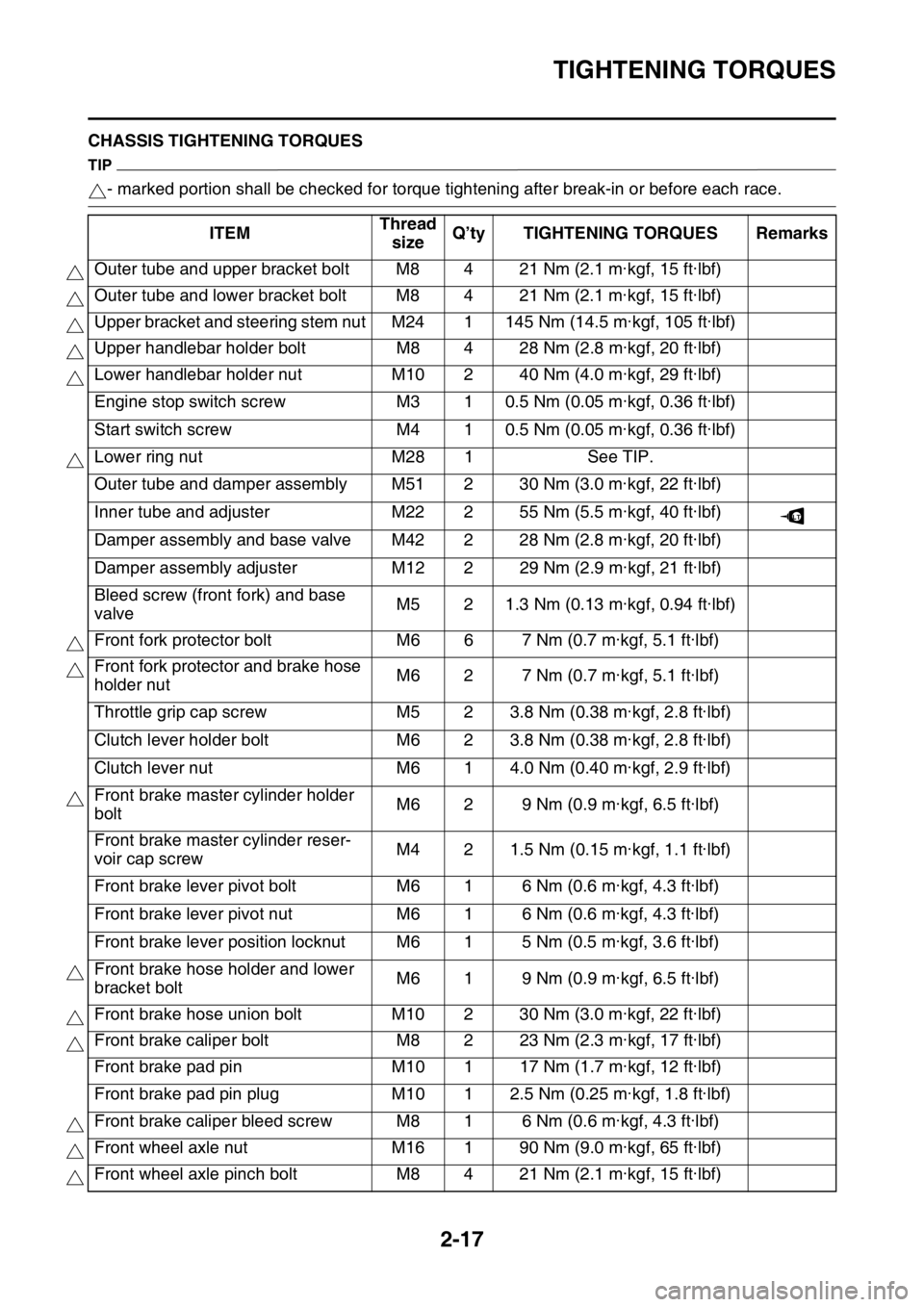
TIGHTENING TORQUES
2-17
EAS2GC1067CHASSIS TIGHTENING TORQUES
TIP
- marked portion shall be checked for torque tightening after break-in or before each race.
ITEM Thread
size Q’ty TIGHTENING TORQUES Remarks
Outer tube and upper bracket bolt M8 4 21 Nm (2.1 m·kgf, 15 ft·lbf)
Outer tube and lower bracket bolt M8 4 21 Nm (2.1 m·kgf, 15 ft·lbf)
Upper bracket and steering stem nut M24 1 145 Nm (14.5 m·kgf, 105 ft·lbf)
Upper handlebar holder bolt M8 4 28 Nm (2.8 m·kgf, 20 ft·lbf)
Lower handlebar holder nut M10 2 40 Nm (4.0 m·kgf, 29 ft·lbf)
Engine stop switch screw M3 1 0.5 Nm (0.05 m·kgf, 0.36 ft·lbf)
Start switch screw M4 1 0.5 Nm (0.05 m·kgf, 0.36 ft·lbf)
Lower ring nut M28 1See TIP.
Outer tube and damper assembly M51 2 30 Nm (3.0 m·kgf, 22 ft·lbf)
Inner tube and adjuster M22 2 55 Nm (5.5 m·kgf, 40 ft·lbf)
Damper assembly and base valve M42 2 28 Nm (2.8 m·kgf, 20 ft·lbf)
Damper assembly adjuster M12 2 29 Nm (2.9 m·kgf, 21 ft·lbf)
Bleed screw (front fork) and base
valve M5 2 1.3 Nm (0.13 m·kgf, 0.94 ft·lbf)
Front fork protector bolt M6 6 7 Nm (0.7 m·kgf, 5.1 ft·lbf)
Front fork protector and brake hose
holder nut M6 2 7 Nm (0.7 m·kgf, 5.1 ft·lbf)
Throttle grip cap screw M5 2 3.8 Nm (0.38 m·kgf, 2.8 ft·lbf)
Clutch lever holder bolt M6 2 3.8 Nm (0.38 m·kgf, 2.8 ft·lbf)
Clutch lever nut M6 1 4.0 Nm (0.40 m·kgf, 2.9 ft·lbf)
Front brake master cylinder holder
bolt M6 2 9 Nm (0.9 m·kgf, 6.5 ft·lbf)
Front brake master cylinder reser-
voir cap screw M4 2 1.5 Nm (0.15 m·kgf, 1.1 ft·lbf)
Front brake lever pivot bolt M6 1 6 Nm (0.6 m·kgf, 4.3 ft·lbf)
Front brake lever pivot nut M6 1 6 Nm (0.6 m·kgf, 4.3 ft·lbf)
Front brake lever position locknut M6 1 5 Nm (0.5 m·kgf, 3.6 ft·lbf)
Front brake hose holder and lower
bracket bolt M6 1 9 Nm (0.9 m·kgf, 6.5 ft·lbf)
Front brake hose union bolt M10 2 30 Nm (3.0 m·kgf, 22 ft·lbf)
Front brake caliper bolt M8 2 23 Nm (2.3 m·kgf, 17 ft·lbf)
Front brake pad pin M10 1 17 Nm (1.7 m·kgf, 12 ft·lbf)
Front brake pad pin plug M10 1 2.5 Nm (0.25 m·kgf, 1.8 ft·lbf)
Front brake caliper bleed screw M8 1 6 Nm (0.6 m·kgf, 4.3 ft·lbf)
Front wheel axle nut M16 1 90 Nm (9.0 m·kgf, 65 ft·lbf)
Front wheel axle pinch bolt M8 4 21 Nm (2.1 m·kgf, 15 ft·lbf)
LT
Page 85 of 426

CABLE ROUTING DIAGRAM
2-34
1. Clutch cable
2. Throttle cable (return)
3. Throttle cable (pull)
4. Engine stop switch lead
5. Coupler for connecting optional part
6. Engine stop switch coupler
7. Rectifier/regulator coupler
8. AC magneto lead
9. Starter knob/idle screw
10. Engine ground sub-lead
11. Starter motor lead
12. Radiator fan fuse
13. Taillight lead
14. Headlight relay (yellow tape)
15. Starting circuit cut-off relay (no identification tape)
16. Diode
17. Holder plate
18. Left of the vehicle:radiator fan motor relay (blue tape)
Right of the vehicle:main relay (red tape)
19. Neutral switch lead
20. Front engine bracket
21. Plastic locking tie
22. Radiator hose
23. Neutral switch coupler
24. Crankshaft position sensor coupler
25. Tension arm
26. Wire harness
27. Tank rail
28. Rectifier/regulator
29. Rectifier/regulator bracket
30. Rear frame
31. Side cover 5
32. Crankcase cover
33. Crankcase
34. Lead holder
35. Frame
36. Engine ground sub-lead coupler
A. Pass the engine stop switch lead between the frame and the cable holder.
B. Insert the coupler for connecting optional part into the connector, and fix it to the bracket.
C. Insert and fix the engine stop switch coupler to the bracket.
D. Insert and fix the rectifie r/regulator coupler to the
bracket.
E. Pass the AC magneto lead to the front of the ve- hicle beyond the starter knob/idle screw and to
the rear of the vehicle beyond the radiator. No
pinch is allowed between the radiator and the
tension arm.
F. Make sure that there is no slack so that the starter motor lead cannot touch the end of the bolt.
G. Place the rear grommet of the starter motor lead matching the rear end of the side cover.
H. Insert the radiator fan motor fuse into the protru- sion of the holder plate.
I. Place the diode on top of the rear fender on the inner side of the rear frame.
J. Bring the neutral switch lead into line with the crankcase cover with no sag allowed.
K. Route the AC magneto lead inside the starter clutch cover.
L. Pass the neutral switch l ead to the inside of the
front engine bracket (the side of the vehicle).
M. Insert the plastic locking tie into the bracket hole and clamp the clutch cable. Clamp it so that the
lock of the plastic locking tie faces downward,
and then cut off the end of the plastic locking tie. N. Pass the clutch cable
with no downward sag al-
lowed.
O. Place the grommet of the clutch cable so that it contacts the radiator hose. Route the clutch cable
outside the neutral switch lead, AC magneto lead
and starter motor lead.
P. Route each lead so that the leads are not pinched
between the radiator hose and the frame.
Q. 40 mm (1.57 in)
R. Clamp the clutch cable, AC magneto lead, neu- tral switch lead and starter motor lead by the plas-
tic locking tie. Make sure that they are clamped at
the positioning tapes in the clutch cable and the
starter motor lead. Make the lock on the plastic
locking tie face the front of the vehicle, and cut
the end.
S. Clamp the starter motor lead to the inside of the tension arm with a plastic locking tie. Clamp it so
that the lock of the plastic locking tie faces up-
ward and outward, and do not cut off the end of
the plastic locking tie. R oute the lead so that there
is no slack at the bottom from the clamp position
onwards.
T. After connecting the neutral switch coupler, at- tach the coupler cover.
U. After connecting the crankshaft position sensor coupler, attach the coupler cover.
V. Pass the rectifier/regulator lead to the inside of the tension arm (the side of the vehicle).
W. Pass the main harness to the front of the radiator
hose (the front of the vehicle), and to the inside of
the clutch cable (the side of the vehicle).
X. Pass the engine stop switch lead between the coupler for connecting optional part and the tank
rail, with the lead on the main harness side facing
the top of the vehicle.
Y. Insert the starter motor lead completely into the end of the side cover 5.
Z. Clamp the clutch cable at the front of the lead (the
front of the vehicle).
AA.Insert the clip of the pl astic locking tie into the
frame. Face the lock of the plastic locking tie for-
ward, and then cut off the end.
Page 93 of 426

CABLE ROUTING DIAGRAM
2-42
1. Clutch switch lead
2. Engine stop switch lead
3. Clutch cable
4. Brake hose guide
5. Headlight lead
6. Speed sensor lead
7. Indicator light coupler
8. Meter assembly optional switch coupler
9. Meter assembly coupler
10. Speed sensor coupler
11. Start switch lead
12. Plastic band
13. Throttle cable
14. Front brake hose
A. Route the throttle cable, clutch cable, clutch switch lead, engine stop switch lead and start
switch lead between the cable guide of the meter
bracket and handle crown. The cables and leads
may be routed in any order.
B. Clamp the wire harness, clutch switch lead and start switch lead to the meter bracket. The clamp
shall be located at a pos ition where there is no
slack with the handle turned fully to the left.
C. Connect the headlight lead to the headlight.
D. Clamp the start switch lead to the handlebar by the plastic band.
E. Clamp the engine stop switch lead and clutch switch lead to the handlebar by the plastic band.
F. 40°±10°
G. Vertical direction
H. Pass the engine stop switch lead under the han- dlebar.
Page 108 of 426
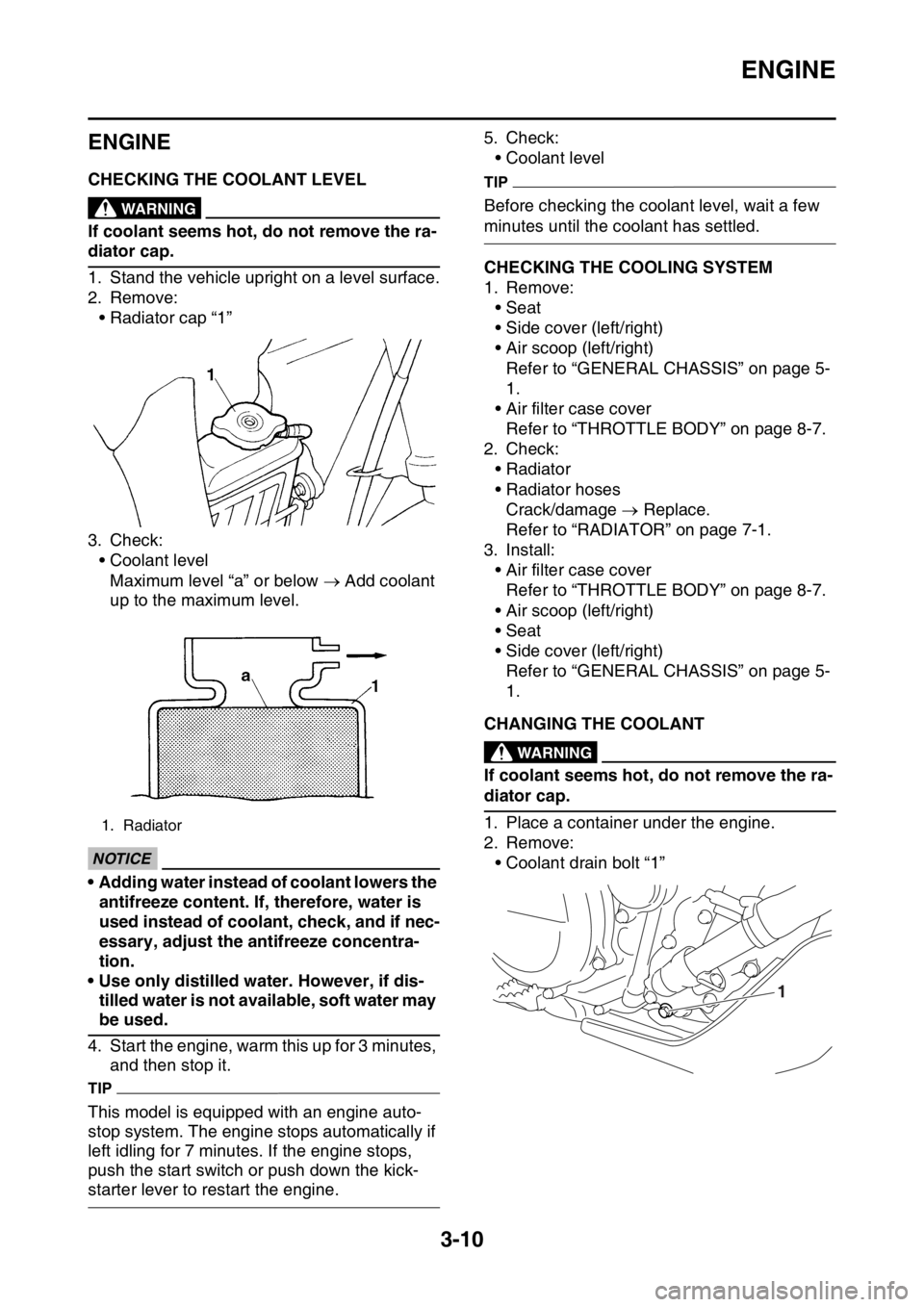
ENGINE
3-10
EAS2GC1081
ENGINE
EAS2GC1082CHECKING THE COOLANT LEVELEWA
WARNING
If coolant seems hot, do not remove the ra-
diator cap.
1. Stand the vehicle upright on a level surface.
2. Remove:• Radiator cap “1”
3. Check: • Coolant levelMaximum level “a” or below Add coolant
up to the maximum level.
ECA
NOTICE
• Adding water instead of coolant lowers the
antifreeze content. If, therefore, water is
used instead of coolant, check, and if nec-
essary, adjust the antifreeze concentra-
tion.
• Use only distilled water. However, if dis- tilled water is not available, soft water may
be used.
4. Start the engine, warm this up for 3 minutes, and then stop it.
TIP
This model is equipped with an engine auto-
stop system. The engine stops automatically if
left idling for 7 minutes. If the engine stops,
push the start switch or push down the kick-
starter lever to restart the engine. 5. Check:
• Coolant level
TIP
Before checking the coolant level, wait a few
minutes until the coolant has settled.
EAS2GC1083CHECKING THE COOLING SYSTEM
1. Remove:• Seat
• Side cover (left/right)
• Air scoop (left/right)Refer to “GENERAL CHASSIS” on page 5-
1.
• Air filter case cover Refer to “THROTTLE BODY” on page 8-7.
2. Check:
• Radiator
• Radiator hosesCrack/damage Replace.
Refer to “RADIATOR” on page 7-1.
3. Install: • Air filter case cover
Refer to “THROTTLE BODY” on page 8-7.
• Air scoop (left/right)
• Seat
• Side cover (left/right) Refer to “GENERAL CHASSIS” on page 5-
1.
EAS2GC1084CHANGING THE COOLANTEWA
WARNING
If coolant seems hot, do not remove the ra-
diator cap.
1. Place a container under the engine.
2. Remove:• Coolant drain bolt “1”
1. Radiator
1
Page 109 of 426
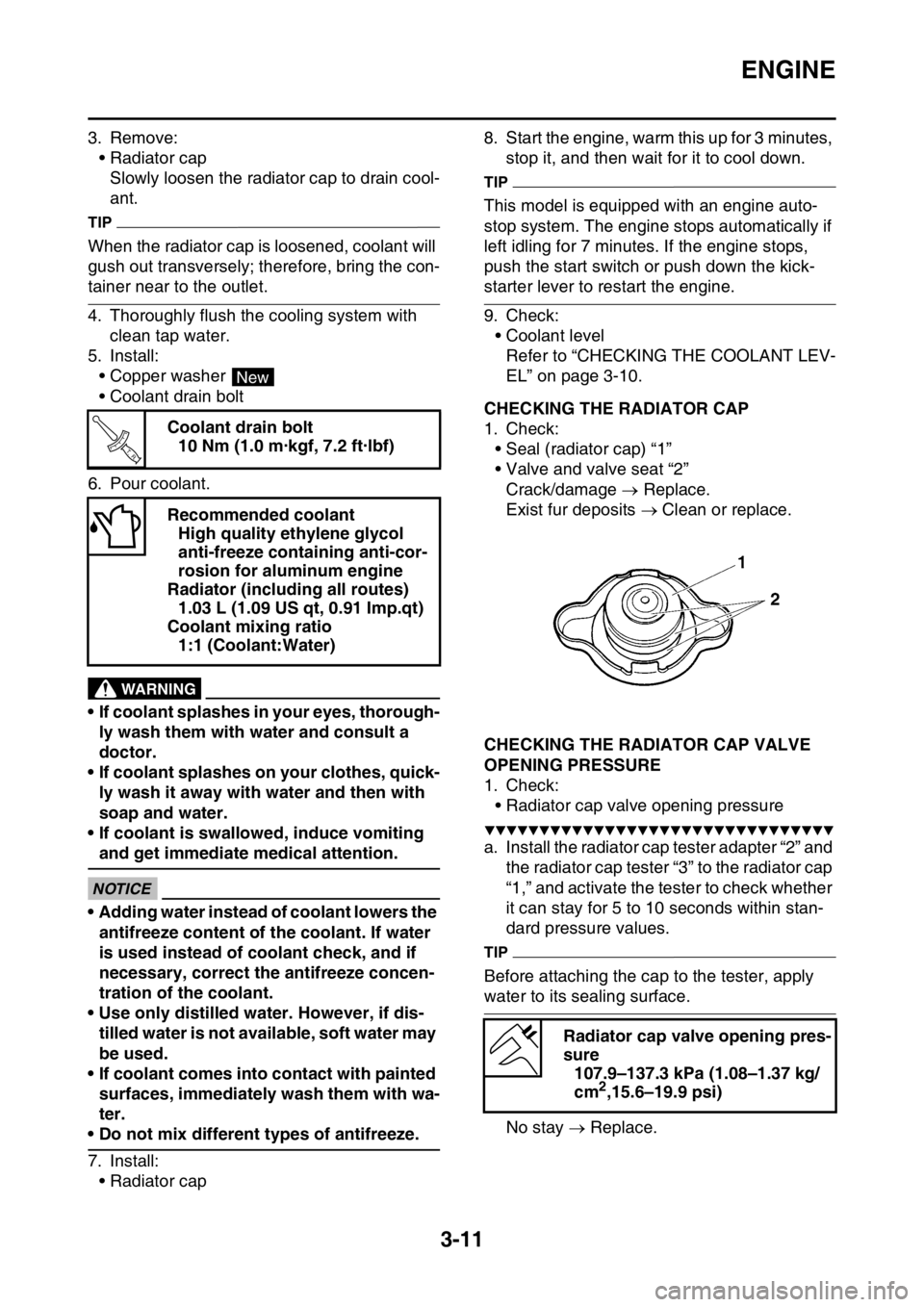
ENGINE
3-11
3. Remove:• Radiator capSlowly loosen the radiator cap to drain cool-
ant.
TIP
When the radiator cap is loosened, coolant will
gush out transversely; therefore, bring the con-
tainer near to the outlet.
4. Thoroughly flush the cooling system with
clean tap water.
5. Install:
• Copper washer
• Coolant drain bolt
6. Pour coolant.
EWA
WARNING
• If coolant splashes in your eyes, thorough- ly wash them with water and consult a
doctor.
• If coolant splashes on your clothes, quick-
ly wash it away with water and then with
soap and water.
• If coolant is swallowed, induce vomiting
and get immediate medical attention.
ECA
NOTICE
• Adding water instead of coolant lowers the
antifreeze content of the coolant. If water
is used instead of coolant check, and if
necessary, correct the antifreeze concen-
tration of the coolant.
• Use only distilled water. However, if dis-
tilled water is not available, soft water may
be used.
• If coolant comes into contact with painted
surfaces, immediately wash them with wa-
ter.
• Do not mix different types of antifreeze.
7. Install:• Radiator cap 8. Start the engine, warm this up for 3 minutes,
stop it, and then wait for it to cool down.
TIP
This model is equipped with an engine auto-
stop system. The engine stops automatically if
left idling for 7 minutes. If the engine stops,
push the start switch or push down the kick-
starter lever to restart the engine.
9. Check:• Coolant levelRefer to “CHECKING THE COOLANT LEV-
EL” on page 3-10.
EAS2GC1085CHECKING THE RADIATOR CAP
1. Check:• Seal (radiator cap) “1”
• Valve and valve seat “2”
Crack/damage Replace.
Exist fur deposits Clean or replace.
EAS2GC1086CHECKING THE RADIATOR CAP VALVE
OPENING PRESSURE
1. Check:
• Radiator cap valve opening pressure
▼▼▼▼▼▼▼▼▼▼▼▼▼▼▼▼▼▼▼▼▼▼▼▼▼▼▼▼▼▼▼▼
a. Install the radiator cap tester adapter “2” and the radiator cap tester “3” to the radiator cap
“1,” and activate the tester to check whether
it can stay for 5 to 10 seconds within stan-
dard pressure values.
TIP
Before attaching the cap to the tester, apply
water to its sealing surface.
No stay Replace.
Coolant drain bolt
10 Nm (1.0 m·kgf, 7.2 ft·lbf)
Recommended coolant High quality ethylene glycol
anti-freeze containing anti-cor-
rosion for aluminum engine
Radiator (including all routes) 1.03 L (1.09 US qt, 0.91 Imp.qt)
Coolant mixing ratio 1:1 (Coolant:Water)
New
T R..
Radiator cap valve opening pres-
sure 107.9–137.3 kPa (1.08–1.37 kg/
cm
2,15.6–19.9 psi)
Page 110 of 426
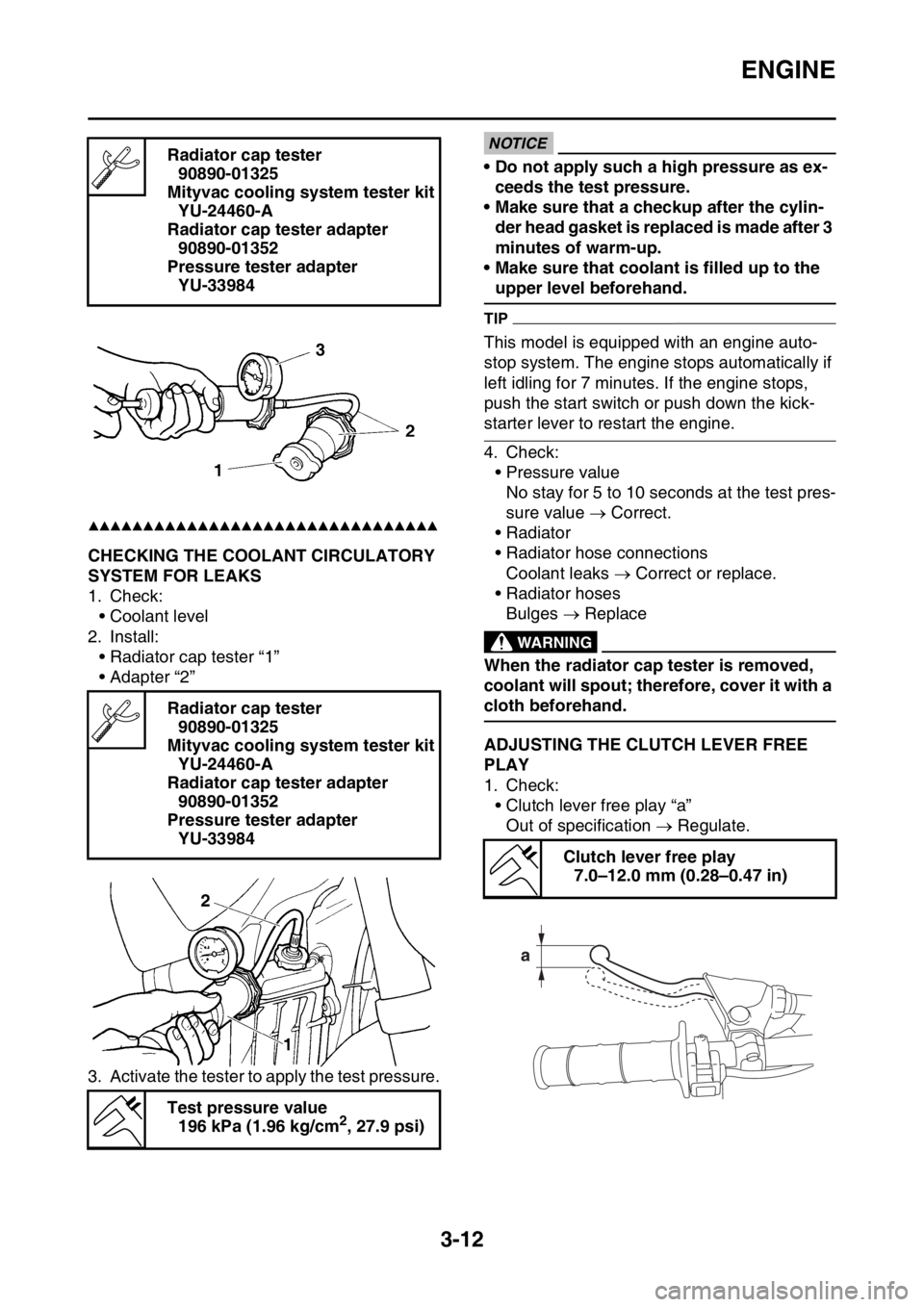
ENGINE
3-12
▲▲▲▲▲▲▲▲▲▲▲▲▲▲▲▲▲▲▲▲▲▲▲▲▲▲▲▲▲▲▲▲
EAS2GC1087CHECKING THE COOLANT CIRCULATORY
SYSTEM FOR LEAKS
1. Check:• Coolant level
2. Install: • Radiator cap tester “1”
• Adapter “2”
3. Activate the tester to apply the test pressure.
ECA
NOTICE
• Do not apply such a high pressure as ex- ceeds the test pressure.
• Make sure that a checkup after the cylin-
der head gasket is replaced is made after 3
minutes of warm-up.
• Make sure that coolant is filled up to the
upper level beforehand.
TIP
This model is equipped with an engine auto-
stop system. The engine stops automatically if
left idling for 7 minutes. If the engine stops,
push the start switch or push down the kick-
starter lever to restart the engine.
4. Check:
• Pressure valueNo stay for 5 to 10 seconds at the test pres-
sure value Correct.
• Radiator
• Radiator hose connections Coolant leaks Correct or replace.
• Radiator hoses Bulges Replace
EWA
WARNING
When the radiator cap tester is removed,
coolant will spout; therefore, cover it with a
cloth beforehand.
EAS2GC1088ADJUSTING THE CLUTCH LEVER FREE
PLAY
1. Check:
• Clutch lever free play “a”Out of specification Regulate.
Radiator cap tester
90890-01325
Mityvac cooling system tester kit YU-24460-A
Radiator cap tester adapter 90890-01352
Pressure tester adapter YU-33984
Radiator cap tester 90890-01325
Mityvac cooling system tester kit YU-24460-A
Radiator cap tester adapter 90890-01352
Pressure tester adapter YU-33984
Test pressure value 196 kPa (1.96 kg/cm
2, 27.9 psi)
Clutch lever free play 7.0–12.0 mm (0.28–0.47 in)
Page 114 of 426
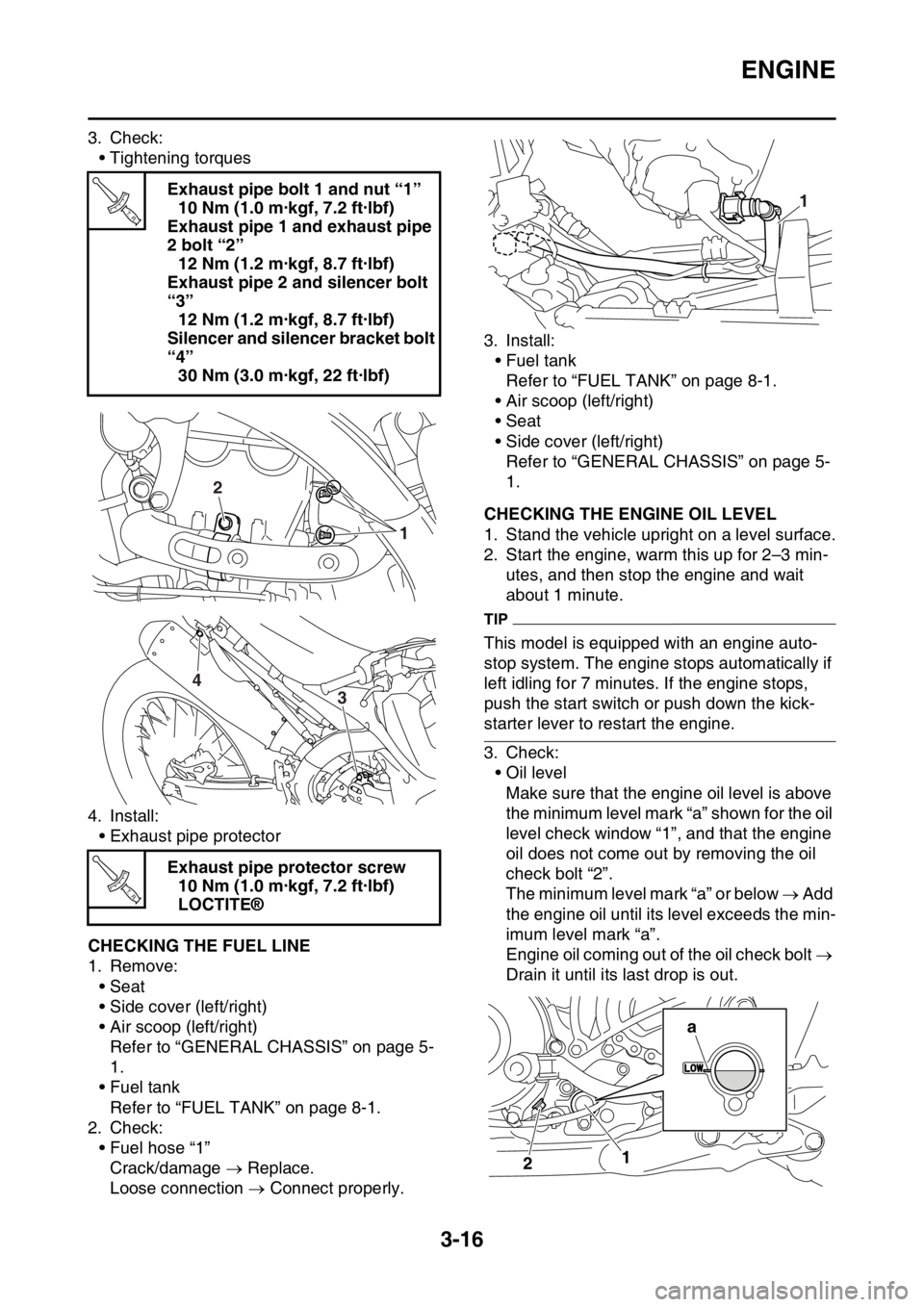
ENGINE
3-16
3. Check:• Tightening torques
4. Install: • Exhaust pipe protector
EAS2GC1095CHECKING THE FUEL LINE
1. Remove:• Seat
• Side cover (left/right)
• Air scoop (left/right)Refer to “GENERAL CHASSIS” on page 5-
1.
• Fuel tank Refer to “FUEL TANK” on page 8-1.
2. Check:
• Fuel hose “1”Crack/damage Replace.
Loose connection Connect properly. 3. Install:
• Fuel tank
Refer to “FUEL TANK” on page 8-1.
• Air scoop (left/right)
• Seat
• Side cover (left/right) Refer to “GENERAL CHASSIS” on page 5-
1.
EAS2GC1096CHECKING THE ENGINE OIL LEVEL
1. Stand the vehicle upright on a level surface.
2. Start the engine, warm this up for 2–3 min- utes, and then stop the engine and wait
about 1 minute.
TIP
This model is equipped with an engine auto-
stop system. The engine stops automatically if
left idling for 7 minutes. If the engine stops,
push the start switch or push down the kick-
starter lever to restart the engine.
3. Check:
• Oil levelMake sure that the engine oil level is above
the minimum level mark “a” shown for the oil
level check window “1”, and that the engine
oil does not come out by removing the oil
check bolt “2”.
The minimum level mark “a” or below Add
the engine oil until its level exceeds the min-
imum level mark “a”.
Engine oil coming out of the oil check bolt
Drain it until its last drop is out.
ECA33DD018
Exhaust pipe bolt 1 and nut “1” 10 Nm (1.0 m·kgf, 7.2 ft·lbf)
Exhaust pipe 1 and exhaust pipe
2 bolt “2” 12 Nm (1.2 m·kgf, 8.7 ft·lbf)
Exhaust pipe 2 and silencer bolt
“3” 12 Nm (1.2 m·kgf, 8.7 ft·lbf)
Silencer and silencer bracket bolt
“4” 30 Nm (3.0 m·kgf, 22 ft·lbf)
Exhaust pipe protector screw 10 Nm (1.0 m·kgf, 7.2 ft·lbf)
LOCTITE®
T R..
2
1
4
3
T R..
1
12
a
Page 115 of 426
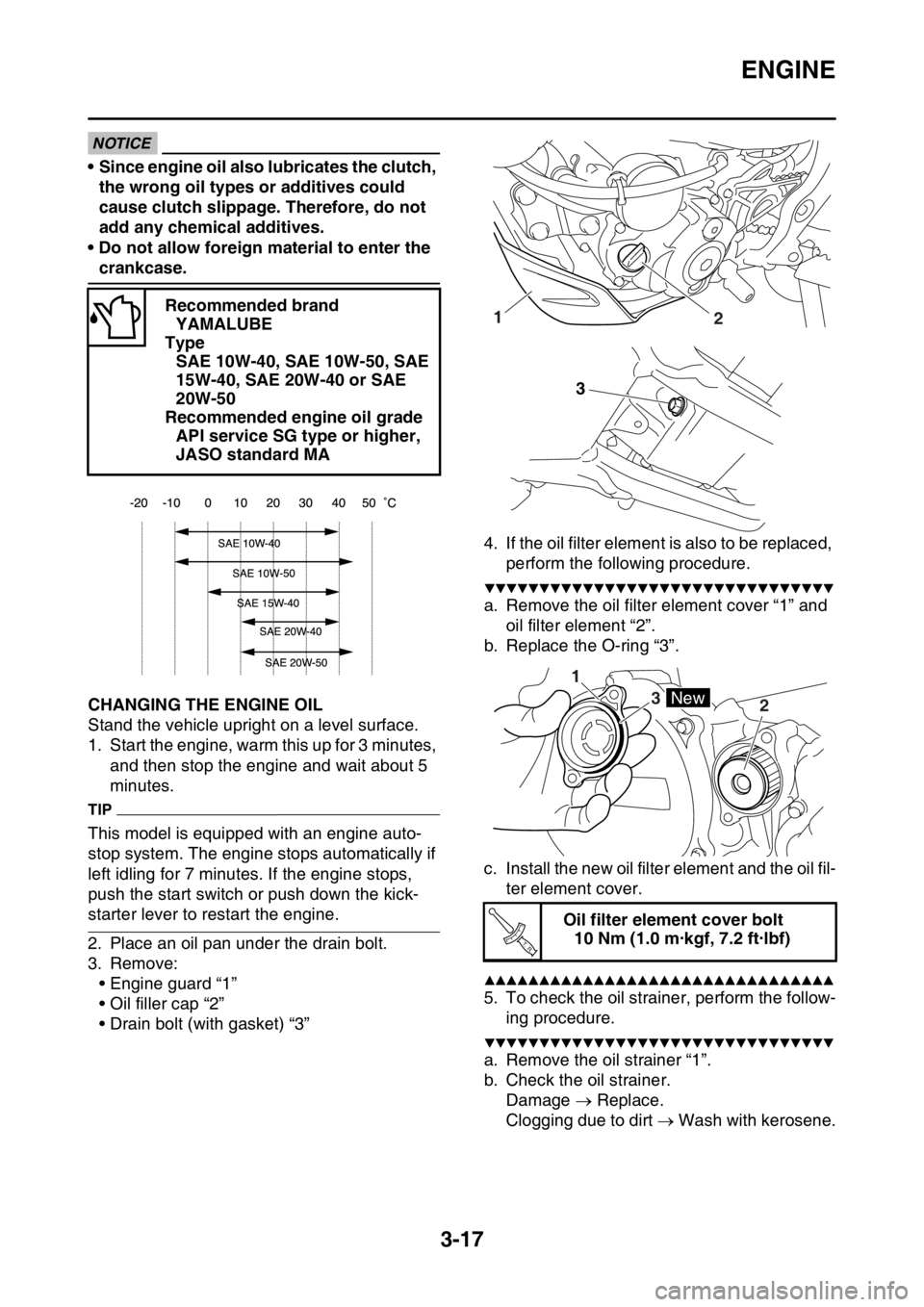
ENGINE
3-17
NOTICE
• Since engine oil also lubricates the clutch, the wrong oil types or additives could
cause clutch slippage. Therefore, do not
add any chemical additives.
• Do not allow foreign material to enter the
crankcase.
EAS2GC1097CHANGING THE ENGINE OIL
Stand the vehicle upright on a level surface.
1. Start the engine, warm this up for 3 minutes, and then stop the engine and wait about 5
minutes.
TIP
This model is equipped with an engine auto-
stop system. The engine stops automatically if
left idling for 7 minutes. If the engine stops,
push the start switch or push down the kick-
starter lever to restart the engine.
2. Place an oil pan under the drain bolt.
3. Remove:• Engine guard “1”
• Oil filler cap “2”
• Drain bolt (with gasket) “3” 4. If the oil filter element is also to be replaced,
perform the following procedure.
▼▼▼▼▼▼▼▼▼▼▼▼▼▼▼▼▼▼▼▼▼▼▼▼▼▼▼▼▼▼▼▼
a. Remove the oil filter element cover “1” and oil filter element “2”.
b. Replace the O-ring “3”.
c. Install the new oil filter element and the oil fil- ter element cover.
▲▲▲▲▲▲▲▲▲▲▲▲▲▲▲▲▲▲▲▲▲▲▲▲▲▲▲▲▲▲▲▲
5. To check the oil strainer, perform the follow-ing procedure.
▼▼▼▼▼▼▼▼▼▼▼▼▼▼▼▼▼▼▼▼▼▼▼▼▼▼▼▼▼▼▼▼
a. Remove the oil strainer “1”.
b. Check the oil strainer.Damage Replace.
Clogging due to dirt Wash with kerosene.
Recommended brand
YAMALUBE
Type SAE 10W-40, SAE 10W-50, SAE
15W-40, SAE 20W-40 or SAE
20W-50
Recommended engine oil grade API service SG type or higher,
JASO standard MA
Oil filter element cover bolt10 Nm (1.0 m·kgf, 7.2 ft·lbf)
12
3
1
3 2
New
T R..
Page 117 of 426
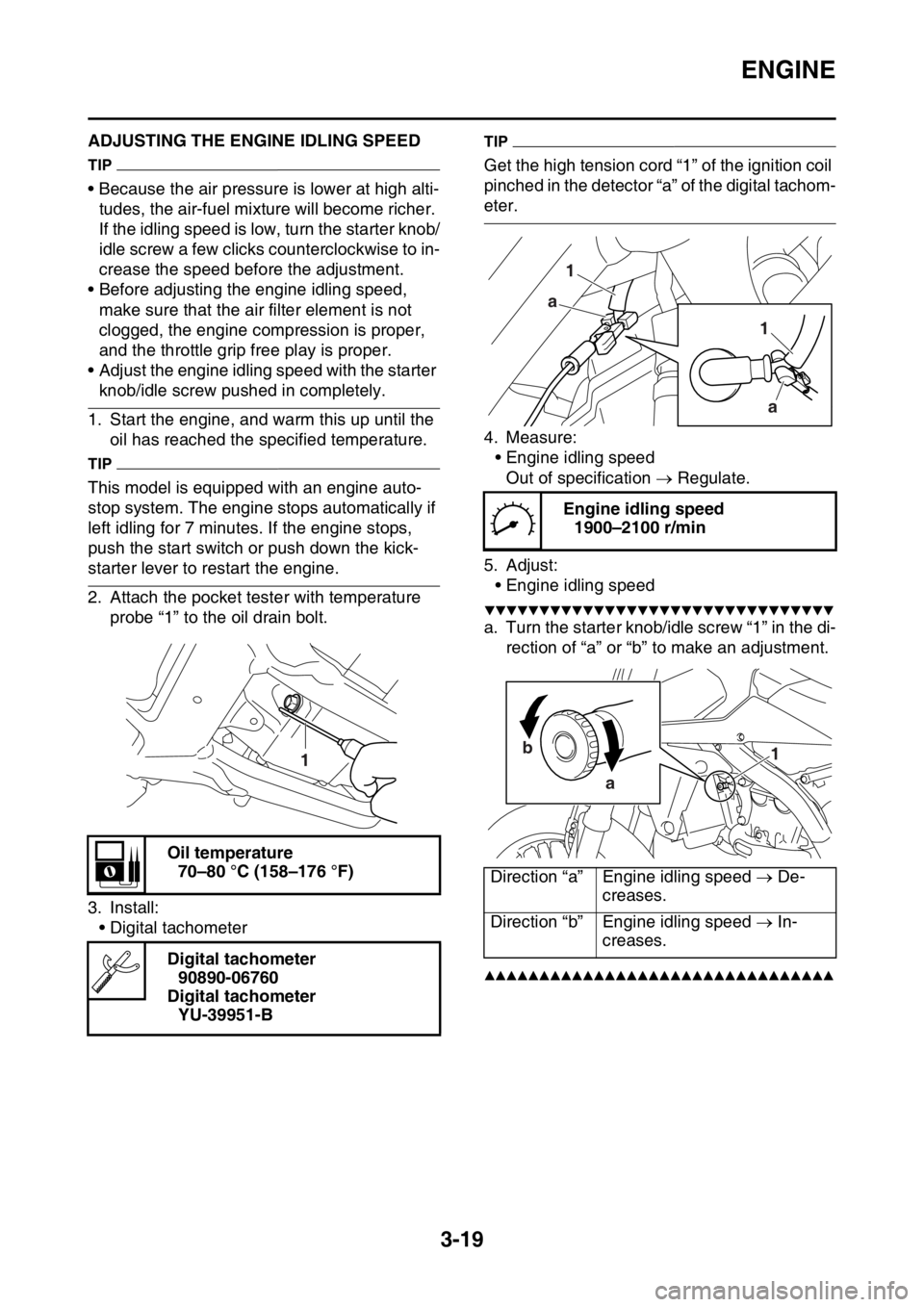
ENGINE
3-19
EAS2GC1098ADJUSTING THE ENGINE IDLING SPEED
TIP
• Because the air pressure is lower at high alti-tudes, the air-fuel mixture will become richer.
If the idling speed is low, turn the starter knob/
idle screw a few clicks counterclockwise to in-
crease the speed before the adjustment.
• Before adjusting the engine idling speed, make sure that the air filter element is not
clogged, the engine compression is proper,
and the throttle grip free play is proper.
• Adjust the engine idling speed with the starter
knob/idle screw pushed in completely.
1. Start the engine, and warm this up until the oil has reached the specified temperature.
TIP
This model is equipped with an engine auto-
stop system. The engine stops automatically if
left idling for 7 minutes. If the engine stops,
push the start switch or push down the kick-
starter lever to restart the engine.
2. Attach the pocket tester with temperature probe “1” to the oil drain bolt.
3. Install: • Digital tachometer
TIP
Get the high tension cord “1” of the ignition coil
pinched in the detector “a” of the digital tachom-
eter.
4. Measure:• Engine idling speed
Out of specification Regulate.
5. Adjust: • Engine idling speed
▼▼▼▼▼▼▼▼▼▼▼▼▼▼▼▼▼▼▼▼▼▼▼▼▼▼▼▼▼▼▼▼
a. Turn the starter knob/idle screw “1” in the di- rection of “a” or “b” to make an adjustment.
▲▲▲▲▲▲▲▲▲▲▲▲▲▲▲▲▲▲▲▲▲▲▲▲▲▲▲▲▲▲▲▲
Oil temperature70–80 °C (158–176 °F)
Digital tachometer 90890-06760
Digital tachometer YU-39951-B
1
Engine idling speed 1900–2100 r/min
Direction “a” Engine idling speed De-
creases.
Direction “b” Engine idling speed In-
creases.
1
1
a
a
1
b
a